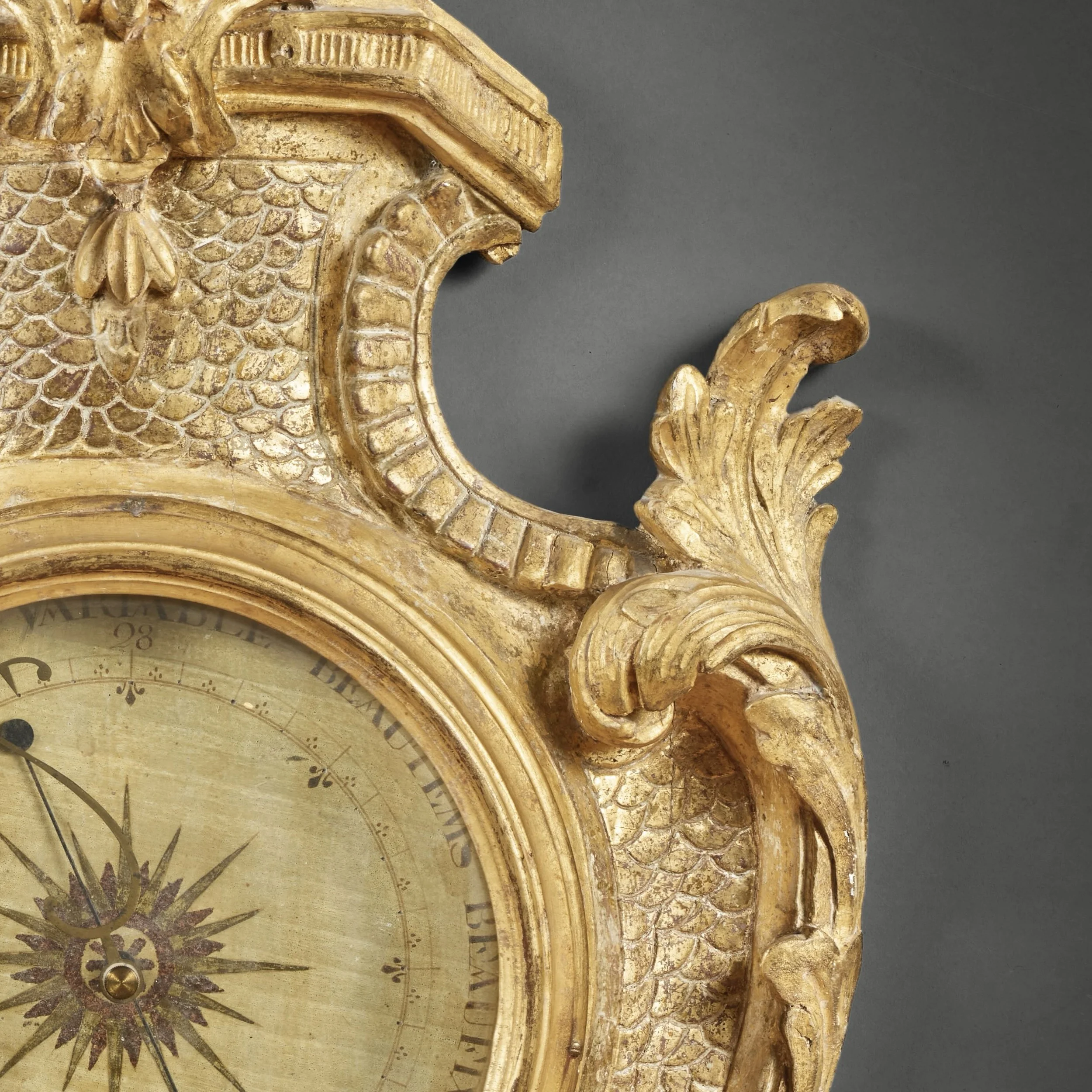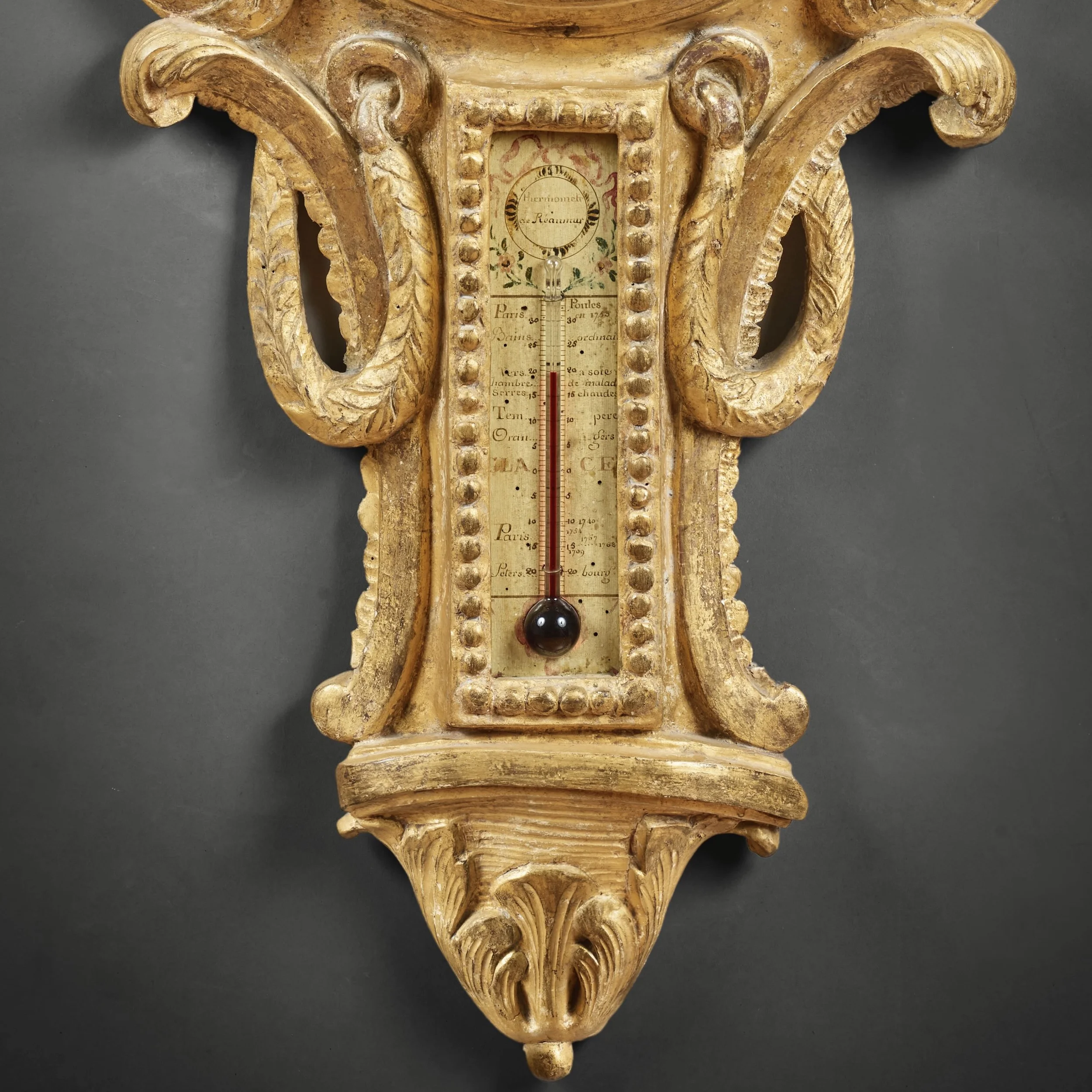Carved barometer-thermometer with fish scales motif
- Description
- Histoire
France,
Louis xvi period
Attributed to Antonio Carcano said Carcani or Carcany (circa 1755–1820)
Carved and gilded wood
The dial is signed: “Par le Sr. Carcanï Rue et faubg St-Antoine a coté La fontaine charonne au Ladons Royaux”
Height: 100 cm – 39 ½ inches
Width: 43 cm – 17 inches
Depth: 5 cm – 2 inches
Comparable examples :
- Antonio Carcano said Carcani or Carcany, Barometer-thermometer with a flower vase, Louis xvi period, circa 1770, former collection of Galerie Léage.
- Antonio Carcano said Carcani or Carcany, Barometer-thermometer with a war trophy, Louis xvi period, last quarter of the 18th century, private collection.
This wall-mounted barometer-thermometer features a tondo-shaped barometer topped by a thermometer framed by a pearl fillet. The circular dial of the barometer unfurls on a background resembling fish scales, surrounded at the top by two dentil friezes, and flanked by C-shaped scrolls and foliate details. The whole is surmounted by a cartouche composed of two facing C-shaped scrolls, between which fan-shaped fleurons are arranged. The whole is crowned with naturalistic flowers. In the lower part, the thermometer is framed by two suspended cords that cross C-shaped scrolls. A foliate base ending in a sheath and surmounted by a cornice forms the end of the lower part. On the dial, a black metal pin points to various meteorological indications inscribed in ink around a compass rose. These indications are arranged clockwise as follows:
- “VARIABLE” [litt. VARIABLE]
- “BEAUTEMS” [litt. FINE WEATHER]
- “BEAUFIXE” [litt. SUNNY WEATHER]
- “TRÉSSEC”[litt. VERY DRY]
- “TEMPÊTE” [litt. STORM]
- “GDE PLUYE” [litt. HEAVY RAIN]
- “PLUYE OU VT“ [litt. RAIN OR WIND]
Also indicated :
- In the North axis, number “28”
- In the South-East axis, number “29”
- In the South-West axis, number “27”
- Signature “Par le Sr. Carcani Rue et faubg St-Antoine a coté La fontaine charonne au Ladons Royaux” [litt. “By Mr. Carcani Rue and Faubourg Saint-Antoine next to the Charonne fountain at the Ladons Royaux”] between the words “TEMPÊTE” and “TRÉSSEC”.
The thermometer features a “Réaumur” gradation, in reference to the temperature scale designed by French physicist and inventor René-Antoine Ferchault de Réaumur in 1731, ranging from 30 degrees Celsius and above to -20 degrees and below. It features a graduated red alcohol test tube set against a decoration combining a temperature scale topped by a ribboned wreath flanked by flowers.
History of the barometer
The first barometer – a mercurial barometer – was invented in 1643 by Evangelista Torricelli. This Italian physicist was the first to demonstrate the existence of atmospheric pressure. During his experiments, he noticed that the height of the mercury in the tube varied with meteorological changes. His Italian contemporary, the 17th-century Irish physicist and chemist Robert Boyle, was the first to use the term “barometer”, from the Greek baros : “weight, gravity”.On an 18th-century barometer like the one shown here, the mechanism developed by Torricelli is located at the back. The atmospheric pressure exerted by the air in the tube on the mercury activates the pin on the dial. The interest in science at the time led craftsmen to combine barometers and thermometers, as is the case here.
History of the thermometer
Traditionally attributed to Galileo, who defined its principle, the invention of the thermometer dates to the mid-17thcentury. It was at this time that the thermometer was developed to measure temperature by dilating a liquid contained in a glass tube.
Over the course of the 17th and 18th centuries, several physicists perfected this instrument, proposing different scales before the adoption of today's scales. In 1654, the Grand Duke of Tuscany, Ferdinand de' Medici, created an alcohol thermometer with 50 graduations. But it wasn't until 1717 that the German Fahrenheit invented the first mercurial thermometer and the scale that bears his name. Then, in 1742, the Swedish Celsius devised a scale ranging from 100°C for freezing water to 0°C for boiling, a gradation that would be reversed after his death. In 1794, the French Convention approved this scale of degrees centigrade, which took several years to become established in France, where it was rivaled by the Réaumur scale presented here. However, the Celsius scale remains the most widely used today.Mercury or alcohol thermometers can be either direct-reading or dial-reading. In the latter case, a mechanism connects a float placed in the column to a pin.
At the end of the 17th century, thermometers and barometers left the scientists’ laboratories and entered the homes of enlightened people. As part of the encyclopedic collections of the 18th century, instruments and machines became increasingly appealing, as much for their decoration and the preciosity of their materials, as for the beauty of their form. With science taking a growing place in society, princes or wealthy aristocrats liked to own instruments associating them with the latest discoveries. While the manufacture of barometer and thermometer mechanisms required the very special skills of an optician, that of the object was entrusted to carpenters who created cases for these instruments.
Antonio Carcano said Carcani or Carcany (circa 1755-1820)
A manufacturer of thermometers, barometers and scientific instruments of Italian origin, Antoine Carcano was born around 1755. Initially established at 37, Rue de la Roquette in the Faubourg Saint-Antoine district of Paris, he later moved to 2, Place Dauphine on the Île de la Cité. This last prestigious address testifies to his success, which enabled him to become “constructeur de baromètres et instruments scientifiques pour l'Ecole Royale Militaire” [manufacturer of barometers and scientific instruments for the Ecole Royale Militaire] in 1786. His signature also bears witness to his new social standing. After initially using his surname, Carcano (sometimes Carcani or Carcany), he changed it to “le sieur Carcarno” [the sire Carcano], followed by his address in the Faubourg Saint-Antoine, specifying that he was based ’a coté La fontaine charonne au Ladons Royaux” [next to the Charonne fountain at the Ladons Royaux] where he built this thermometer-barometer. Later, he would further emphasize his professional success by adding that he was a “builder of barometers for the Ecole Royale Militaire” and specified his new location at Place Dauphine.
On October 12th, 1792, after serving for a month as a citizen soldier and Bastille gendarme in the 48th Popincourt Battalion, Antoine Carcano sent a letter to the Secretary of the National Convention requesting that “his petition be sent to the Minutes, War and Military Committees, so that he can carry out his experiments ”
Antoine Carcano also enjoyed an international clientele. In 1787, he supplied the English optician Peter Dollond (1731-1821) in London with tubes for his barometers marked “Fecit Carcano”, while on August 30th, 1813, the Anglo-American physicist Benjamin Thompson, known to posterity as Rumford (after his title of Earl of Rumford), presented a thermometric vase made by Carcano that he used in his research on heat radiation. Seven years later, the American professor William Davis Merry Howard published a description of Carcano's differential thermometer, which he had just received, confirming that the French scientist was able to resume his activity after the French Revolution, and return to his workshop on the Île de la Cité.
Bibliography:
- Daniel Alcouffe, Anne Dion, Gérard Mabille, Les bronzes d’ameublement du Louvre, Dijon, Faton, 2004, p. 213, n°108.
- Bibliothèque universelle des sciences, belles-lettres, et arts faisant suite à la Bibliothèque Britannique, Tome 13, fifth year, Imprimerie de la Bibliothèque universelle, 1820, p.249.
- Antoine Carcano, Lettre manuscrite d’Antoine Carcano adressée à la Convention nationale, dated October 12, 1792, and received October 13, Paris, Archives Nationales (ref. C//241 1792).
- Camille Frémontier-Murphy, « Une collection d’instruments scientifiques au musée du Louvre», L’Estampille‑L’Objet d’Art, n°342, December 1999, p. 40–53.
- Chevreul, Dumas, and al., Annales de Chimie et de Physique, sixième série, tome I, Paris, G. Masson Éditeur, p.288
- Alexandre Tuetey, Répertoire général des sources manuscrites de l’histoire de Paris pendant la Révolution française, Paris, Imprimerie Nouvelle, 1890–1914, Year 1908, Volume 8, page 23, article 167.



